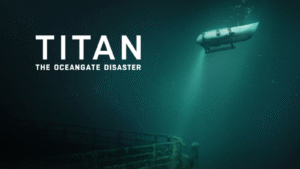The Fatal Descent: Unpacking Ambition and Hubris in Netflix’s “Titan: The OceanGate Disaster”
Netflix’s “Titan: The OceanGate Disaster” plunges viewers into the chilling depths of a modern-day tragedy, meticulously dissecting the ill-fated submersible expedition that captivated and horrified the world in 2023. More than just a recount of events, the documentary serves as a stark cautionary tale, laying bare the dangerous alchemy of unchecked ambition, technological hubris, and a dismissive attitude towards established safety protocols. Through a blend of harrowing accounts, expert analysis, and revealing archival footage, the film paints a grim picture of a disaster that, in hindsight, appears tragically avoidable.

The Unchecked Ambition of Stockton Rush
At the core of the documentary is the figure of Stockton Rush, the CEO of OceanGate and the visionary — or perhaps, the deluded dreamer — behind the Titan submersible. The film masterfully portrays Rush as a man driven by an almost messianic zeal to “innovate” deep-sea exploration, often at the expense of conventional engineering wisdom and human safety. Accounts from former employees, dubbed “the Whistleblower” and “the Insider,” reveal a corporate culture where dissenting voices were silenced, safety concerns were dismissed as impediments to progress, and industry regulations were actively circumvented. The documentary highlights the fatal flaw in the Titan’s design – its carbon fiber hull – a material choice repeatedly flagged as unsuitable for extreme pressures by experts, yet stubbornly championed by Rush. The chilling audio recordings of “popping sounds” from within the submersible during test dives, brushed aside by Rush as insignificant, serve as a visceral testament to the ignored warnings that ultimately sealed the fate of the five souls on board.
Societal Dimensions and Media Scrutiny
“Titan: The OceanGate Disaster” extends beyond a mere technical post-mortem, delving into the psychological and societal dimensions that contributed to the catastrophe. It probes the allure of extreme tourism, where wealth grants access to audacious, and ultimately dangerous, expeditions. The documentary implicitly questions the moral responsibility of those who fund and participate in such ventures, even when presented with clear risks. The film also examines the media frenzy that surrounded the submersible’s disappearance, showcasing how a profound tragedy could simultaneously become a morbid spectacle of online memes and breathless, often ill-informed, speculation. This public fascination, the documentary suggests, further amplified the sense of grandiosity that fueled Rush’s vision.
Human Cost and Lasting Impact
While the film provides a comprehensive and unsettling exposé of OceanGate’s operational failures and Rush’s fatal leadership style, its strength lies in its ability to humanize the victims. Through interviews with family members and glimpses into the lives of the passengers, the documentary ensures that the audience never loses sight of the immense human cost of the disaster. This grounding in personal tragedy prevents the film from becoming solely a technical analysis, imbuing it with a profound emotional resonance.
Conclusion: A Cautionary Tale
In conclusion, “Titan: The OceanGate Disaster” is a powerful and necessary documentary that serves as a sobering examination of the consequences of unchecked ambition and the dangers of disregarding established safety norms in the pursuit of revolutionary ideas. It forces us to confront uncomfortable questions about risk, responsibility, and the ethical boundaries of human endeavor, particularly when lives are at stake. The film’s unflinching portrayal of the events leading up to the implosion of the Titan submersible leaves an indelible mark, reminding us that even in the age of rapid innovation, the fundamental principles of safety and due diligence must never be sacrificed at the altar of progress.




















